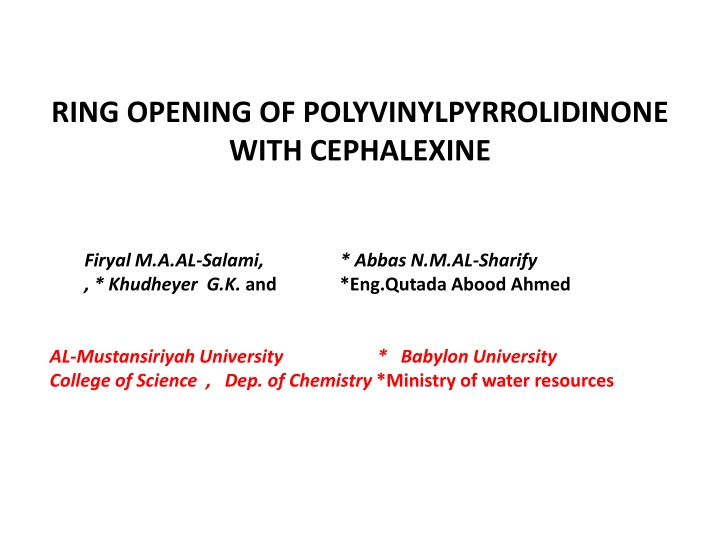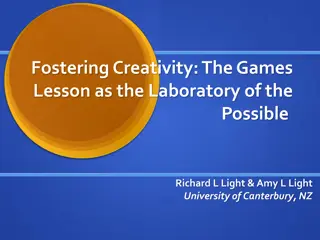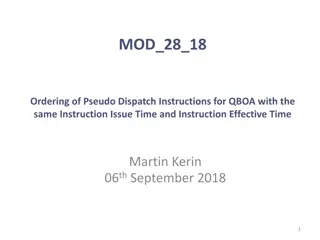Monday Lesson Plan - Specific Instructions for Creativity
Students in this lesson will practice giving and following specific instructions using a water bottle demonstration, exploring the connection to computer programming. They will then work with a partner to apply these concepts, fostering creativity and identity expression.
Download Presentation

Please find below an Image/Link to download the presentation.
The content on the website is provided AS IS for your information and personal use only. It may not be sold, licensed, or shared on other websites without obtaining consent from the author.If you encounter any issues during the download, it is possible that the publisher has removed the file from their server.
You are allowed to download the files provided on this website for personal or commercial use, subject to the condition that they are used lawfully. All files are the property of their respective owners.
The content on the website is provided AS IS for your information and personal use only. It may not be sold, licensed, or shared on other websites without obtaining consent from the author.
E N D
Presentation Transcript
RING OPENING OF POLYVINYLPYRROLIDINONE WITH CEPHALEXINE Firyal M.A.AL-Salami, * Abbas N.M.AL-Sharify , * Khudheyer G.K. and *Eng.Qutada Abood Ahmed AL-Mustansiriyah University * Babylon University College of Science , Dep. of Chemistry *Ministry of water resources
ABSTRACT: In this work a new drug polymer was prepared from reaction of PVP with Cephalexine as -lactam antibiotic in 10:1 dioxane :DMF solvent mixture. The prepared drug polymer was formed with 85% conversion percentage. The physical properties were studied and intrinsic viscosity was equal to 0.9 dl/g. The drug polymer was characterized by FTIR and UV. Spectroscopy. The swelling % were studied in different non solvents. The C.H.N analysis and DSC were analyzed. The controlled release rates for drug polymer were studied in different pH values at 37 0C for 4days. The softening point of the prepared Cephalexine drug polymer was 143.4-150.3 0C with Keywords: Ring Opening; Polyvinyl Pyrrolidinone ;Cephalexine
Experimental Materials cephalexin was provided from Sammura Company, and all other chemicals were purchased from Merck, and polyvinylpyrrolidinone was obtained from Fluka. All available chemical reagents were used without further purification. FTIR spectra were taken on a Shimadizu spectrophotometer recorder over the range500-4000cm-1. Ultraviolet spectra was recorded using Shimadzu UV-VIS recorder. Differential Scanning Calorimeter( DSC) study was carried out on a Shimadzu.60 instrument(Japan) at a heating rate of 10C0 min- 1,under air (normal), not vacuum. temperature range from -140 0C temperature up to 600 0C ,The detector type K for the furnace temperature as shown in Fig.(1). C.H.N analysis were determined by analyzer type 1106 Carlo Irba.
Modification of Polyvinylpyrrolidinon PVP with cephalexine (5,6) A mixture of (5g., 0.045 mole) of PVP and 10:1 Dioxane:DMF were placed in a round bottom flask equipped with a reflux condenser and a magnetic stirrer. Then (1.621g., 0.045 mole) of dissolved cephalexine was added gradually, refluxed for 1hour, then left the mixture about 10 hours. The colorless viscous polymer was reprecipitate from 50ml of ethanol, the pure polymer was obtained 85% conversion%.
Controlled Released study (7,8,9,10) A 100 mg of modified cephalexine drug polymer was kept in a cylinder containing 50:50ml of buffer:dioxane and in a water bath at 300C without stirring. A sample from the release medium was periodically withdrawn and analyzed by UV. At 300nm to determine the amount of the released cephalexine. A calibration curve was constructed with a software built in the computerized UV. Spectrophotometer, the amount 0.1 mg of the released cephalexine was determined directly from the software for many days, using the calibration curve in different pH values at 37 0C as shown in Fig.(4).
Swelling studies Swelling Percentage of prepared polymer was studied which equals to 8% in acetone and 10% in hexane as shown in Fig.(5). swelling% was calculated according to m= m1-m0/m0 100 When m0 is the weight of a dry drug polymer m1 is the swallowed polymer in non solvent The softening point of the drug polymer was 143.4- 150.3 C0 which measured by using Differential Scanning Calormeter( DSC.60) Shimadza.
Result and Discussion Poly(N-vinyl-2-pyrrolidinone) is a white hygroscopic powder, forming hard clear films. Physical properties are determined on films or powder. The polymer strongly interacts through dipole- dipole attraction. The ring opening reaction of PVP with NH2 cephalexine is illustrated as in mechanism as in scheme 1. Scheme -1-
Due to the presence of NH2 group which is strong nucleophilic attach, the ring opining of pyrrolidinone produced prodrug polymer. The polvinypyrrolidinon connected with amide cephalexine moiety affords both protection and specific transport properties with longer acting release with higher reactivity in suitable site and this type of drug polymer which hydrolysis in fabrications conditions to delivery of agents, for therapeutic against disceases state. And sustained rate, targeted delivery of drugs and to minimize toxicity and enhanced selectivity. The structural characterization was done by FTIR spectrum Fig.(3) showed peaks at 3225 cm-1 assigned to NH- and at 3450cm-1 assigned to characteristic absorption of carboxylic acid for cephalexine and the absoption appeared at 1633cm-1 and 1666cm-1 assigned to C=O stretching of amide, and 3080cm-1 was attributed to C-H stretching of aromatic ring, and peak at 2960cm-1 assigned to aliphatic C-H stretching ;on the other hand, the FTIR showed peaks at 1580cm-1 and 1600 cm-1 due to C=C stretching of the aromatic ring of cephalexine, the FTIR of drug polymer which compared with Fig.(2) of FTIR spectra of PVP.
The physical properties of prepared cephalexine polymer were studied such as intrinsic viscosity which was measured at 30 0C with Ostwald viscometer by using dioxane as a solvent.( [ in]= 0.9dl/g). Fig.(4) shows the effects of pH values on the rate of controlled release and profiles of mole fraction of cephalexine ratio to total moles present in the sample versus time at pH values 4 and 10 at 37 0C. The only nucleophilic acyl substitution reaction that amides is hydrolysis, Amides are fairly stable in water, but the amide bond is cleaved on the heating in the prescience of strong acid or bases, Norminally this cleavage produces an amine and carboxylic acid.
The release of the drug at suitable condition gradually with outside effect, this hydrolysis of amide group which shown in the following mechanism (7,8) . In acid, however, the amine is protonated giving an ammonium ion :-
In base the carboxylic acid is deprotonated, giving a carboxylate ion :-
The purpose of this research was to synthesize polymer based smart bioactive cephalexine prodrug polymer and one of the main goal in this work is investigation of efficient drug carrier and the effect of pH values on drug release at 37 0C as illustrated in Fig(4) .The hydrolysis rate of this amide bond acts as base > acid. The result indicated higher hydrolysis in basic medium (9,10,11) .
Fig.(1) Thermal Analysis (DSC) Result of polyvinylpyrrolidinone with cephalexine
Fig.(3) IR spectrum of polyvinylpyrrolidinone with cephalexine (drug polymer )
Fig.(4) Controlled release drug polymer at 370C in different pH values























